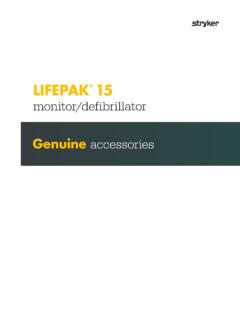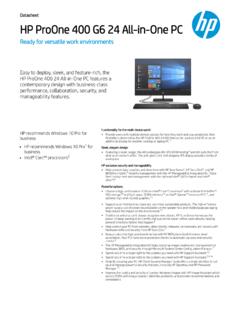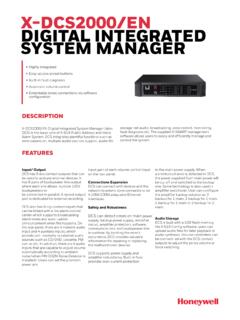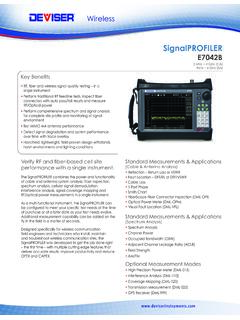Transcription of LIFEPAK 15 monitor/defibrillator
1 Ease of use More than 20 clearly labeled, dedicated buttons Front-facing cables, connectors, and 100mm printerClinical effectiveness 360J biphasic ST-segment trending University of Glasgow 12-Lead ECG Analysis ProgramLIFEPAK 15 monitor/defibrillator Data sheetSpecificationsGeneralThe LIFEPAK 15 monitor/defibrillator has six main operating modes: AED mode: for automated ECG analysis and a prompted treatment protocol for patients in cardiac mode: for performing manual defibrillation, synchronized cardioversion, noninvasive pacing, and ECG and vital sign mode: for accessing stored patient mode: for changing default settings of the operating mode: for authorized personnel to perform diagnostic tests and mode: for simulated waveforms and trend graphs for demonstration characteristicsWeight: Basic monitor/defibrillator with new roll paper and two batteries installed: lb ( kg) Fully featured monitor/defibrillator with new roll paper and two batteries installed: lb ( kg)Lithium-ion battery: lb ( kg)Accessory bags and shoulder strap: lb ( kg)Standard (hard) paddles: lb ( kg)Height: in ( cm)Width.
2 In ( cm)Depth: in ( cm)DisplaySize (active viewing area): in (212 mm) diagonal; in (171 mm) wide x in (128 mm) high Resolution: display type 640 dot x 480 dot color backlit LCDUser selectable display mode: full color or SunVue display high contrast Display: a minimum of 5 seconds of ECG and alpha-numerics for values, device instructions, or promptsDisplay: up to three waveformsWaveform display sweep speed: 25 mm/sec for ECG, Sp02, IP, and mm/sec for CO2 Data managementThe device captures and stores patient data, events (including waveforms and annotations), and continuous waveform and patient impedance records in internal user can select and print reports, and transfer the stored information via supported communication types: Three format types of CODE SUMMARY critical event record: short, medium, and long 12-lead ECG with STEMI statements Continuous Waveform (transfer only) Trend Summary Vital Sign Summary SnapshotMemory capacity.
3 Total capacity is 360 minutes of continuous ECG, 90 minutes of continuous data from all channels, or 400 single waveform memory capacity for a single patient includes up to 200 single waveform reports and 90 minutes of continuous device is capable of transferring data records by wired or wireless connection. This device complies with Part 15 of the FCC rules, and its operation is subject to the following two conditions: (1) this device may not cause harmful interference, and (2) this device must accept any interference received, including interference that may cause undesired operation.
4 Serial Port RS232 communication + 12V available Limited to devices drawing maximum A current Bluetooth technology provides short-range wireless communication with other Bluetooth-enabled devicesMonitorECGECG is monitored via several cable arrangements:A 3-wire cable is used for 3-lead ECG 5-wire cable is used for 7-lead ECG 10-wire cable is used for 12-lead ECG acquisition. When the chest electrodes are removed, the 10-wire cable functions as a 4-wire paddles or QUIK-COMBO pacing/defibrillation/ECG electrodes are used for paddles lead response: Monitor: to 40 Hz or 1 to 30 Hz Paddles: to 30 Hz 12-lead ECG diagnostic: to 150 HzLead selection.
5 Leads I, II, III, (3-wire ECG cable) Leads I, II, III, AVR, AVL, and AVF acquired simultaneously (4-wire ECG cable) Leads I, II, III, AVR, AVL, AVF, and C lead acquired simultaneously (5-wire ECG cable) Leads I, II, III, AVR, AVL, AVF, V1,V2,V3,V4,V5, and V6 acquired simultaneously (10-wire ECG cable)ECG size: 4, 3, , 2, , 1, , cm/mV (fixed at 1 cm/mV for 12-lead)Durability LIFEPAK TOUGH Dual-layer screen protector Large, shock absorbing handle Reliability Upgradeable platform Daily, 3AM diagnostic self-testLIFEPAK 15 monitor/defibrillatorHeart rate display: 20 300 bpm digital display Accuracy: 4% or 3 bpm, whichever is greater QRS Detection Range Duration: 40 to 120 msec Amplitude: to mCommon mode rejection (CMRR): ECG Leads: 90 dB at 50/60 HzSp02/SpC0/SpMetSensors.
6 MASIMO sensors including RAINBOW sensors NELLCOR sensors when used with the MASIMO RED MNC adapterSp02 Displayed saturation range: <50 for levels below 50%; 50 to 100%Saturation accuracy: 70 100% (0 69% unspecified)Adults/pediatrics: 2 digits (during no motion conditions) 3 digits (during motion conditions)Dynamic signal strength bar graphPulse tone as Sp02 pulsations are detectedSp02 update averaging rate user selectable: 4, 8, 12 or 16 secondsSp02 sensitivity user selectable: Normal, HighSp02 measurement: Functional Sp02 values are displayed and storedPulse rate range: 25 to 240 bpmPulse rate accuracy (adults/pediatrics).
7 3 digits (during no motion conditions) 5 digits (during motion conditions)Optional Sp02 waveform display with autogain controlSpC0 SpC0 concentration display range: 0 to 40%SpC0 accuracy: 3 digitsSpMET SpMet saturation range: 0 to display resolution: up to 10%SpMet accuracy: 1 d i g itNIBPB lood pressure systolic pressure range: 30 to 255 mmHgDiastolic pressure range: 15 to 220 mmHgMean arterial pressure range: 20 to 235 mmHgUnits: mmHgBlood pressure accuracy: 5 mmHgBlood pressure measurement time: 20 seconds, typical (excluding cuff inflation time)Pulse rate range: 30 to 240 pulses per minutePulse rate accuracy: 2 pulses per minute or 2%, whichever is greaterOperation features initial cuff pressure: User selectable, 80 to 180 mmHgAutomatic measurement time interval: User selectable, from 2 min to 60 minAutomatic cuff deflation excessive pressure: If cuff pressure exceeds 290 mmHgExcessive time: If measurement time exceeds 120 secondsCO2CO2 range: 0 to 99 mmHg (0 to kPa)Units: mmHg, %, or kPaRespiration rate accuracy: 0 to 70 bpm: 1 bpm 71 to 99 bpm: 2 bpmRespiration rate range: 0 to 99 breaths/minuteRise time: 190 msecResponse time.
8 Seconds (includes delay time and rise time)Initialization time: 30 seconds (typical), 10-180 secondsAmbient pressure: automatically compensated internallyOptional display: CO2 pressure waveform Scale factors: Autoscale, 0 20 mmHg (0 4 Vol%), 0 50 mmHg (0 7 Vol%), 0 100 mmHg (0 14 Vol%)Invasive pressureTransducer type: Strain-gauge resistive bridgeTransducer Sensitivity: 5 V/ V/mmHgExcitation voltage: 5 VdcConnector: Electro Shield: CXS 3102A 14S-6 SBandwidth: Digital filtered, DC to 30 Hz (< -3db)Zero drift: 1 mmHg/hr without transducer driftZero adjustment: 150 mmHg including transducer offsetNumeric accuracy: 1 mmHg or 2% of reading, whichever is greater, plus transducer errorPressure range: -30 to 300 mmHg, in six user selectable rangesInvasive pressure display Display: IP waveform and numericsUnits: mmHgLabels: P1 or P2, ART, PA, CVP, ICP, LAP (user selectable)TemperatureRange: to F ( to C) Resolution: CAccuracy: C including sensorReusable temperature cable: 5 foot or 10 footDisposable sensor types: Surface Skin.
9 Esophageal/RectalTrendTime scale: Auto, 30 minutes, 1, 2, 4, or 8 hoursDuration: Up to 8 hoursST segment: After initial 12-lead ECG analysis, automatically selects and trends ECG lead with the greatest ST displacementDisplay choice of: HR, PR (SpO2), PR (NIBP), SpO2 (%), SpCO (%), SpMet (%), CO2 (EtCO2/FiCO2), RR (CO2), NIBP, IP1, IP2, STAlarmsQuick set: Activates alarms for all active vital signsVF/VT alarm: Activates continuous (CPSS) monitoring in Manual modeNo breath alarm: Occurs when 30 seconds has elapsed since last detected respirationHeart rate alarm limit range: Upper, 100 250 bpm.
10 Lower, 30 150 bpmInterpretive algorithm12-Lead interpretive algorithm: University of Glasgow 12-Lead ECG Analysis Program, includes AMI and STEMI statementsPrinterPrints continuous strip of the displayed patient information and reportsPaper size: in (100 mm)Print speed: 25 mm/sec or mm/sec Optional: 50 mm/sec time base for 12-lead ECG reportsDelay: 8 secondsAutoprint: Waveform events print automaticallyFrequency response: Diagnostic: to 150 Hz or to 40 Hz Monitor: to 40 Hz or 1 to 30 HzDefibrillatorBiphasic waveform: Biphasic Truncated ExponentialThe following specifications apply from 25 to 200 ohms, unless otherwise specified:Energy accuracy: 1 joule or 10% of setting, whichever is greater, into 50 ohms, 2 joules or 15% of setting, whichever is greater, into 25-175 compensation: Active when disposable therapy electrodes are attached.





